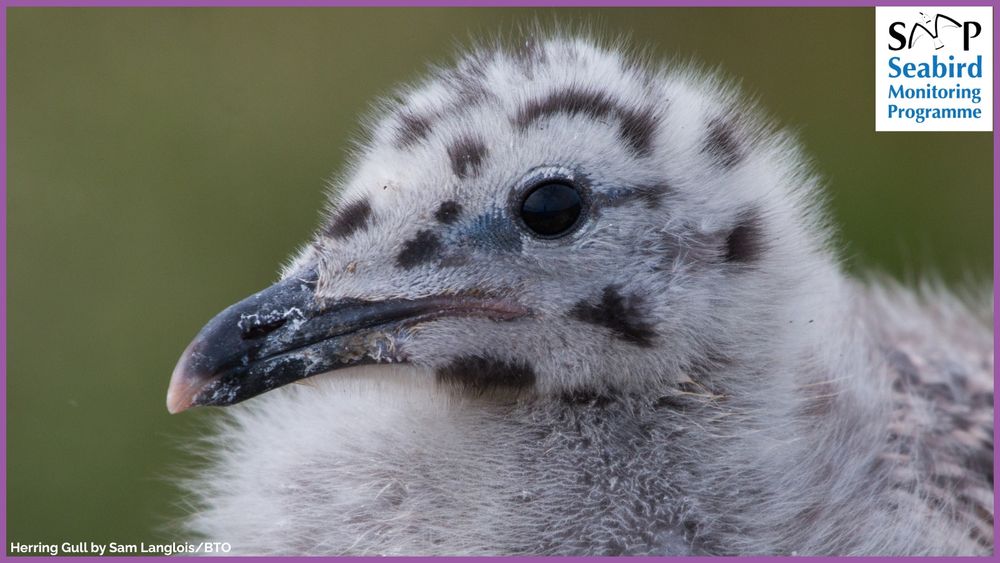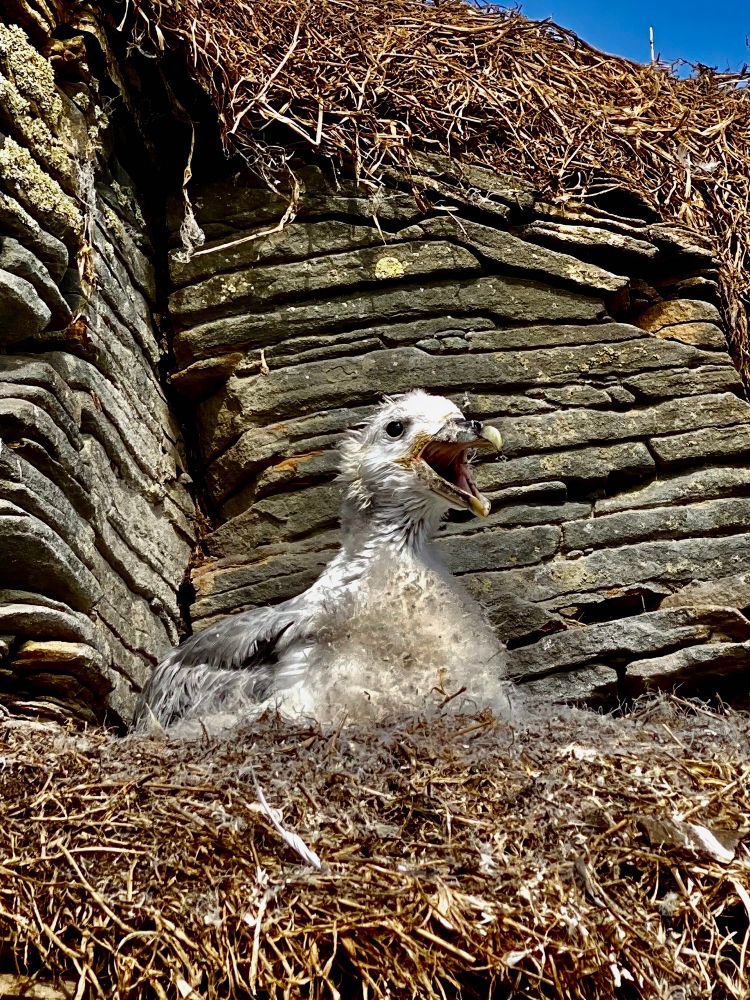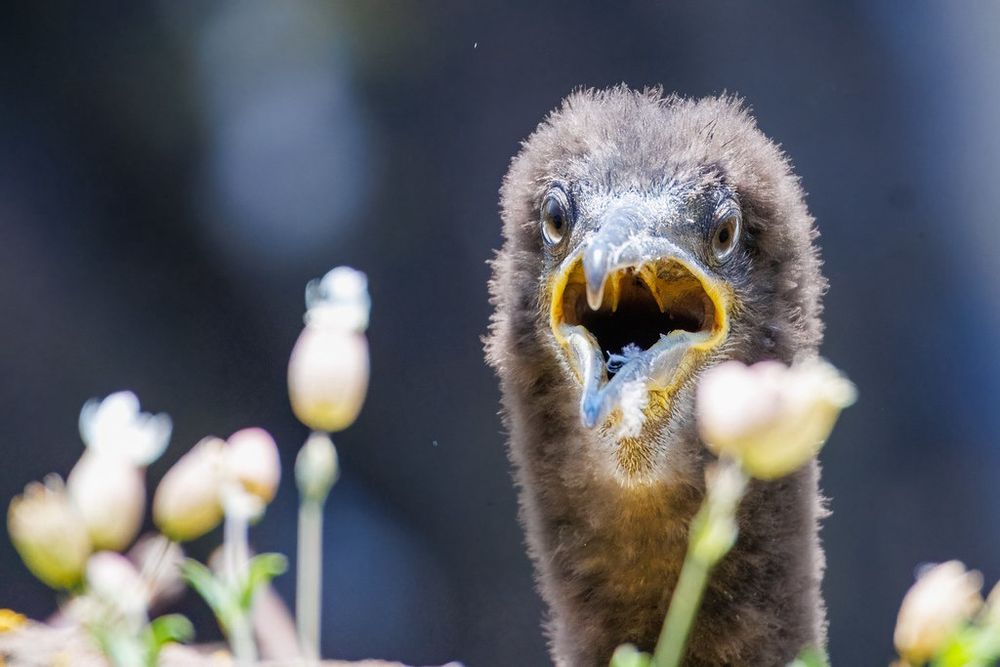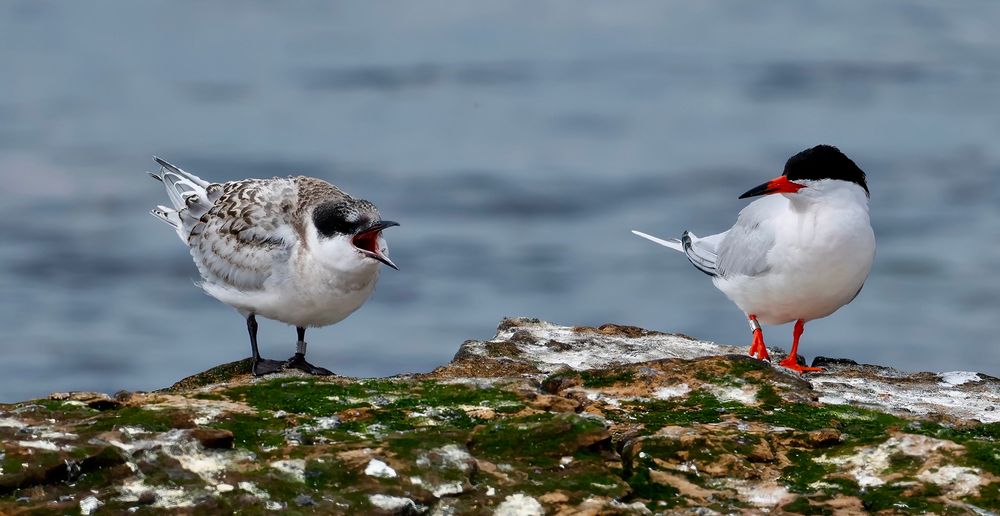
Graphic displays a juvenile Cormorant (left) and a juvenile Shag (right) both photographed by Edmund Fellowes/BTO. Each image is labelled with key identifying features. For the Cormorant, these are: 'Shallow sloping forehead', 'Thick neck', and 'Much white' in the chest and belly. For the Shag, these are: 'Steep sloping head', 'Thin neck', and 'White restricted to chin'. The Seabird Monitoring Programme logo is found in the bottom right hand corner.
The caption reads: '2/ Juveniles are even trickier, sharing features such as their brown toned plumage and white chin patch.
Still, with a bit of practice, they can be differentiated!
Juveniles are even trickier, sharing features such as their brown toned plumage and white chin patch.
Still, with a bit of practice, they can be distinguished!
06.10.2025 13:57 — 👍 7 🔁 1 💬 0 📌 0

Graphic displays a Cormorant photographed by John Harding/BTO (left) and a Shag photographed by Liz Cutting/BTO (right). The species are labelled with their English and Latin names, Phalacrocorax carbo and Phalacrocorax aristotelis, respectively. Each image is labelled with key identifying features. For the Cormorant, these are: 'Heavy bill and a gradually sloped forehead', 'White chin', 'Blue sheen', 'White patch on thigh', and 'Variable amounts of white in the neck'. For the Shag, these are: 'Breeding crest', 'Green sheen', 'Lacks white in chin and neck', and 'Light bill and a steeply sloped forehead'. The Seabird Monitoring Programme logo is found in the bottom right hand corner.
The caption reads: '1/ 1/ Despite a reasonable difference in size, Cormorants and Shags can be quite difficult to differentiate unless side by side!
In this thread ⬇️, we take a look at some of the key differences between adults and juveniles... #seabirds #birds @btobirds.bsky.social @jncc.bsky.social @rspb.bsky.social'
1/ Despite a reasonable difference in size, Cormorants and Shags can be quite difficult to differentiate unless side by side!
In this thread ⬇️, we take a look at some of the key differences between adults and juveniles... #seabirds #birds @btobirds.bsky.social @jncc.bsky.social @rspb.bsky.social
06.10.2025 13:57 — 👍 48 🔁 16 💬 2 📌 1

Image of a deceased Puffin lying on the ground. White wording on an orange background reads: Please report sightings of dead birds.
⚠️ Please report sightings of dead birds for possible testing for Avian Influenza. ⬇️
📌 In England, Wales & Scotland: www.gov.uk/guidance/...
📌 In Northern Ireland: www.daera-ni.gov.uk/...
📌 In Republic of Ireland: aviancheck.apps.serv...
#UKBirding #BirdingWales #BirdingScotland
04.10.2025 18:00 — 👍 43 🔁 52 💬 1 📌 1

Sheep Island. Photo by Sorrel Lyall / BTO

Camera trap set up on Sheep Island. Photo by Sorrel Lyall / BTO

Members of the BTO Northern Ireland team retrieving camera traps from Sheep Island. Photo by Nia Potapova / BTO

Cormorants by Edmund Fellowes / BTO
🐏 Last week the BTO NI team and staff from the National Trust retrieved cameras monitoring a Cormorant colony on Sheep Island
📸 This footage will be vital for understanding coastal-breeding Cormorants, which lack consistent productivity data in Northern Ireland
#seabirds #ConservationScience🌍
30.09.2025 13:33 — 👍 41 🔁 9 💬 0 📌 0

Graphic displays a Black Guillemot photographed by Edmund Fellowes/BTO with a thought bubble extending from its head and the internal text 'Just one month to submit your breeding seabird data to the SMP!'. The SMP logo is positioned in the top left hand corner. The caption reads: 'Yes, that's right!
You have until October 31st to submit your breeding seabird data to the SMP so that it can be utilised in understanding how species have faired this year! #seabirds'
Yes, that's right!
You have until October 31st to submit your breeding seabird data to the SMP so that it can be utilised in understanding how species have faired this year! #seabirds @btobirds.bsky.social @jncc.bsky.social @rspb.bsky.social
01.10.2025 07:11 — 👍 20 🔁 15 💬 0 📌 0

Graphic displays a photo by Sam Langlois/BTO of a Herring gull adult and chick. In the top right hand corner is the Seabird Monitoring Programme logo. The caption reads: 'So, there you have it!
From fluffy down, to a mixture of browns, whites, and greys, through to the smart white and grey of an adult, Herring Gulls are an excellent species to get stuck into for learning about moult and ageing!'
So, there you have it!
From fluffy down, to a mixture of browns, whites, and greys, through to the smart white and grey of an adult, Herring Gulls are an excellent species to get stuck into for learning about moult and ageing!
26.09.2025 09:08 — 👍 3 🔁 0 💬 1 📌 0

Graphic displays a photo by Aaron McKay/BTO of a Herring gull. In the top right hand corner is the Seabird Monitoring Programme logo. The caption reads: 'Now, the plumage is that of a winter adult! No brown is mixed in with the grey of the back and wings, and the face and neck is heavily streaked. The bill is yet to fully yellow, still being pale pink at the base suggesting this is a sub-adult, though soft parts do develop at varying rates! '
Now, the plumage is that of a winter adult! No brown is mixed in with the grey of the back and wings, and the face and neck is heavily streaked.
The bill is yet to fully yellow, still being pale pink at the base suggesting this is a sub-adult, though soft parts do develop at varying rates!
26.09.2025 09:08 — 👍 2 🔁 0 💬 1 📌 0

Graphic displays a photo by Aaron McKay/BTO of a Herring gull. In the top right hand corner is the Seabird Monitoring Programme logo. The caption reads: 'Suddenly, the wings are largely grey and the primaries have distinct 'mirrors'. The iris is also turning pale and much of the black on the bill is gone. The red gonys spot is developing! Still, features like the brown in the wing and tail feathers show that they're still a way from being an adult!'
Suddenly, the wings are largely grey and the primaries have distinct 'mirrors'. The iris is also turning pale and much of the black on the bill is gone. The red gonys spot is developing!
Still, features like the brown in the wing and tail feathers show that they're still a way from being an adult!
26.09.2025 09:08 — 👍 2 🔁 0 💬 1 📌 0

Graphic displays a photo by Aaron McKay/BTO of a Herring gull. In the top right hand corner is the Seabird Monitoring Programme logo. The caption reads: 'The characteristic grey feathers start coming through in the mantle and scapulars in their second year. The all-black juvenile bill also begins to change colour, taking on a pale pink tinge. One day it'll be the characteristic yellow and red!'
The characteristic grey feathers start coming through in the mantle and scapulars in their second year.
The all-black juvenile bill also begins to change colour, taking on a pale pink tinge. One day it'll be the characteristic yellow and red!
26.09.2025 09:08 — 👍 3 🔁 0 💬 1 📌 0

Graphic displays a photo by Aaron McKay/BTO of a Herring gull. In the top right hand corner is the Seabird Monitoring Programme logo. The caption reads: 'Once their down is replaced, they are a mix of white, grey, and brown. Key features to look out for are the 'piano-key' appearance of the greater coverts, and the white notches in the tertials! This individual has replaced some mantle and scapula feathers. New ones have a distinct anchor pattern!'
Once their down is replaced, they are a mix of white, grey, and brown. Key features to look out for are the 'piano-key' appearance of the greater coverts, and the white notches in the tertials!
This individual has replaced some mantle and scapula feathers. New ones have a distinct anchor pattern!
26.09.2025 09:08 — 👍 3 🔁 0 💬 1 📌 0

Graphic displays a photo by Sam Langlois/BTO of a Herring gull chick. In the top right hand corner is the Seabird Monitoring Programme logo. The caption reads: 'Herring Gull plumage varies vastly between hatching and becoming adults! Initially, they are leggy balls of black-speckled down, soon to embark on a shifting plumage journey!
Discover their plumage changes in this thread⬇️ #seabirds #birds @btobirds.bsky.social @jncc.bsky.social @rspb.bsky.social'
Herring Gull plumage varies vastly between hatching and becoming adults! Initially, they are leggy balls of black-speckled down, soon to embark on a shifting plumage journey!
Discover their plumage changes in this thread ⬇️ #seabirds #birds @btobirds.bsky.social @jncc.bsky.social @rspb.bsky.social
26.09.2025 09:08 — 👍 31 🔁 11 💬 1 📌 0
Big thanks to all the SMP surveyors who contribute data to this long-term survey which feeds into the UK Seabird Indicator
23.09.2025 14:41 — 👍 4 🔁 1 💬 0 📌 0

Graphic displays a Herring Gull photographed by Edmund Fellowes/BTO with the English and Latin (Larus argentatus) names to it's left. There is a 'Key Facts' box which includes the following information in a more concise form: 36% Breeding Expansion, 12 Year average lifespan, has a varied diet, lays 2-4 eggs, is seen year round, and there are 130,000 pairs in the UK. In the top right hand corner is the SMP logo, and photo credit in the bottom left corner. The caption reads: 'SMP Species Focus 2: The Herring Gull - A raucous bunch who often draw negative attention to themselves via their poor mannered food pinching in urban settings! This week’s content will show that they’re much more than that! #seabirds #birds'
SMP Species Focus 2: The Herring Gull - A raucous bunch who often draw negative attention to themselves via their poor mannered food pinching in urban settings! This week’s content will show that they’re much more than that! #seabirds #birds @btobirds.bsky.social @jncc.bsky.social @rspb.bsky.social
22.09.2025 09:06 — 👍 19 🔁 6 💬 0 📌 1

Graphic Displays four pictures of Guillemots, three by Sam Langlois and one by Philip Croft. Each picture has a small text description relevant to the photo. From left to right these are: (1) 61-73cm wingspan, (2) Backwards facing denticles to grip slippery fish, (3) 'Bridled' morph has a white orbital ring and trailing eye line, and (4) Feet well developed for swimming despite still being covered in down. The Seabird monitoring programme logo is in the bottom right corner.
The caption is as follows: 'Part two of our Guillemot focus! Some of their features can be challenging to see when they’re densely packed on ledges of sea cliffs, so here’s a closer look at some adaptations, biometrics, and plumage quirks!'
Part two of our Guillemot focus!
Some of their features can be challenging to see when they’re densely packed on ledges of sea cliffs, so here’s a closer look at some adaptations, biometrics, and plumage quirks! #seabirds #birds @btobirds.bsky.social @jncc.bsky.social @rspb.bsky.social
17.09.2025 09:18 — 👍 24 🔁 7 💬 0 📌 0

Graphic displays a picture of a Guillemot perched on a rock by Edmund Fellowes/BTO. It contains the SMP logo, the species' English and Latin name, and the following key facts with appropriate graphics: status: common, average age: 23, eats fish, lays one egg, is present year round, and there are 950,000 pairs around the UK. The post's caption reads: ‘Species Focus: The Guillemot - Noisy yet agile, they are a staple of many cliff faces around the UK and Ireland during the breeding season! More to come in the week on these splendid seabirds... #seabirds #birds'
Species Focus: The Guillemot - Noisy yet agile, they are a staple of many cliff faces around the UK and Ireland during the breeding season! More to come in the week on these splendid seabirds... #seabirds #birds @btobirds.bsky.social @jncc.bsky.social @rspb.bsky.social
15.09.2025 11:09 — 👍 32 🔁 9 💬 0 📌 1

Graphic displays a mixed flock of gulls with arrows and text boxes identifying species including Herring, Lesser Black Backed, Greater Black Backed, and Black Headed Gull and their key identifying features. These are 'Sub-Adults have a pale inner primary window', 'Classic pale grey back and wings of adults', and un-streaked head of summer plumage and streaked head of winter plumage for Herring Gulls. 'Small gull compared to the others here. Black head of summer plumage has been lost, but characteristic thin red beak is present' for Black Headed Gull. 'Thin billed and grey of back lighter than that of Great Black Backed Gull. Adults have bright yellow legs' for Lesser Black Backed Gull. 'Bulbous bill', 'Black wings', larger size than adjacent herring gulls', and 'Fleshy pink-toned legs' for Greater Black Backed Gull. The caption provides a link to the SMP newsletter: http://www.bto.org/smp-news where further identification tips can be found for small gulls.
Varied plumages makes identifying gulls tricky! This graphic identifies key features to look for on some of our common species. More tips on small gull identification can be found in the latest SMP news: www.bto.org/smp-news #seabirds #birds @btobirds.bsky.social @jncc.bsky.social @rspb.bsky.social
10.09.2025 09:21 — 👍 28 🔁 14 💬 1 📌 2

Graphic displays two fulmars, one sat on a cliff face and the second about to land next to the other. The sitting bird has its beak open and there is a speech bubble with the text ‘IT’S SMP DATA SUBMISSION TIME!’ emerging from its mouth. The caption reads ‘With the seabird breeding season ending, and many species returning to sea or their wintering grounds, it’s the perfect opportunity to submit your breeding data to the Seabird Monitoring Programme! (deadline: end of October) #seabirds’
With the seabird breeding season ending, and many species returning to sea or their wintering grounds, it’s the perfect opportunity to submit your breeding data to the Seabird Monitoring Programme! (deadline: end of October) #seabirds @btobirds.bsky.social @jncc.bsky.social @rspb.bsky.social
03.09.2025 10:16 — 👍 17 🔁 18 💬 1 📌 0

Graphic displays the results to a previous post titled ‘Commic Tern QUIZ’. It includes a labelled image of a Common Tern on the left half of the graphic, with species name and the features ‘large white cheek patch’, ‘wings from the centre of the body’, ‘relatively short tail streamers’, and ‘only inner primaries are translucent’ connected to the relevant parts of the bird with arrows. On the right hand side of the graphic is a labelled image of an Arctic Tern, with species name and the labelled features ‘distinctly contrasting white cheek’, ‘short-necked appearance’, ‘long tail streamers’, and ‘primaries ‘translucent’ with contrasting dark band on their trailing edge’ connected to the relevant parts of the bird with arrows. The caption reads: ‘Here is the answer to last week’s Commic Tern Quiz! Let us know how you did in the comments and get out spotting these aerial acrobats before they’re gone until next year! #Seabirds’.
Here is the answer to last week’s Commic Tern Quiz! Let us know how you did in the comments and get out spotting these aerial acrobats before they’re gone until next year! #Seabirds @btobirds.bsky.social @jncc.bsky.social @rspbscience.bsky.social
01.09.2025 12:20 — 👍 27 🔁 9 💬 1 📌 0

A Guillemot has its bill wide open, as wording alongside reads: We're Hiring. Seabird monitoring programme organiser. www.bto.org/jobs
Last chance to apply! 📢 We're looking for a Seabird Monitoring Programme Organiser. For the full job role and to apply visit www.bto.org/jobs
Deadline for applications is Monday 8 September.
#Ornithology @jncc.bsky.social @rspbscience.bsky.social
01.09.2025 06:00 — 👍 30 🔁 28 💬 0 📌 0

Results are in for the Isle of May seabird breeding season. Fulmar breeding success was 41%. An average season with the long term mean at 40% @theseabirdgroup.bsky.social @smp-seabirds.bsky.social @ukceh.bsky.social
25.08.2025 11:02 — 👍 29 🔁 6 💬 1 📌 0

ALT text: Graphic displays two tern species in flight with ‘Commic Tern QUIZ’ and ‘...but who’s who’ across the images. Below, information on the identification of Common and Arctic Terns is displayed. For Arctic Tern, the identification list includes: ‘short-necked’ appearance, all primaries ‘translucent’ with contrasting dark band on trailing edge of primaries, long tail streamers, distinctly contrasting white cheek.
For Common Terns, the identification list includes: wings from centre of the body (not front-heavy as in Arctic Tern), only inner primaries are ‘translucent’, relatively short tail streamers, large white cheek patch.
Common & Arctic Terns are migrating south through the UK and Ireland right now! They are often lumped together as ‘Commic’ Terns. Use this graphic and tell us who’s who! Answer coming next Monday! #Seabirds @btobirds.bsky.social @jncc.bsky.social @rspbscience.bsky.social
26.08.2025 11:21 — 👍 13 🔁 4 💬 0 📌 0

Adult Roseate Tern and youngster on the Northumberland coast. Safe journey, and hopefully we'll see the adult next year and the youngster in a couple of years. @theseabirdgroup.bsky.social @smp-seabirds.bsky.social #seabirds #nebirding #birdsoftheworld
08.08.2025 10:53 — 👍 77 🔁 10 💬 1 📌 1

We are back on the Isle of May for the final bit of breeding season monitoring. Fulmar checks are now complete. We'll be sharing all the Isle breeding season results very soon. @smp-seabirds.bsky.social @theseabirdgroup.bsky.social
18.08.2025 14:29 — 👍 50 🔁 8 💬 0 📌 0

‘Adorable’, Fulmar chick still in the nest on the #Northumberlandcoast Be careful not to get too close, as you might just receive a shower you wouldn’t like. #seabirds @theseabirdgroup.bsky.social @smp-seabirds.bsky.social #nebirding
02.08.2025 06:58 — 👍 59 🔁 6 💬 0 📌 0

This Shag fledgling has all my Monday morning feels.
#isleofmay #birdingscotland #seabirds
04.08.2025 06:07 — 👍 49 🔁 5 💬 0 📌 0
Come and join our top Surveys team!!
29.07.2025 12:25 — 👍 6 🔁 3 💬 0 📌 1
A great opportunity for a career involved in #Seabird monitoring with @btobirds.bsky.social! 🕊️🐦🐣🦅
30.07.2025 22:46 — 👍 11 🔁 8 💬 0 📌 0
Hi Carol, this is a desk-based role coordinating the schemes participants of professional and skilled volunteer participants. You do get to think about seabirds all day and work with fantastic people, so it is still very rewarding.
29.07.2025 13:34 — 👍 4 🔁 0 💬 0 📌 0

Job Advert reads:
Work with us!
Seabird Monitoring Programme Organsier
www.bto.org/jobs
With a photo of a Razorbill flying behind the text.
📢Job alert! We’re looking for the next Seabird Monitoring Programme Organiser to join the BTO Surveys Team!🔭📈
ℹ️ For more information and to apply: www.bto.org/jobs
🗓️ Deadline for applications: 8th Sept 2025.
#seabirds #citizenscience
@btobirds.bsky.social, @jncc.bsky.social, @rspb.bsky.social
29.07.2025 10:12 — 👍 32 🔁 40 💬 1 📌 3

“Terning a Deaf Ear” Roseate Tern and youngster on the Northumberland coast. #nebirding #birds #seabirds @theseabirdgroup.bsky.social @smp-seabirds.bsky.social @ntbirdclub.bsky.social
22.07.2025 07:11 — 👍 34 🔁 5 💬 0 📌 0
Supporting BTO members/volunteers in Bridgend, Caerphilly, Cardiff, Merthyr Tydfil, RCT & Vale of Glamorgan UAs. Hyrwyddo gwaith y BTO yn Ne Ddwyrain Morgannwg.
Organiser of the Wetland Bird Survey (WeBS) and Goose & Swan Monitoring Programme (GSMP) at BTO, Nunnery Lakes obsessive & wildlife photographer. Views my own.
Birds, conifers and some green & pro-European politics.
Strictly no DMs (any sent, won't be read).
Monitoring, researching and recording bird migration & the wildlife of Cape Clear. Part of Birdwatch Ireland, the largest independent conservation organisation in Ireland. CCBO is an accredited member of the Bird Observatories Council.
Beacon Lagoons Little Tern Project - Protecting Yorkshire's only breeding Little Terns, a stone's throw from Spurn Point. Please view the colony from Long Bank.
Whiskey? No, I can't - it'll curdle my Baileys. 🧐
Easington/ Spurn
BirdLife International- Middle East is a global Partnership of conservation organizations that strives to conserve birds, their habitats and global biodiversity.
Birds Know no borders... And neither do we
Nature addict from Dorset 🦊 Calf of Man Estate Warden 2025 🐦 A Permit Ringer | Former BTO Training Officer, Bardsey Bird Obs AW & LTV at WWT Slimbridge & Spurn Bird Obs 🦆 (She/Her)
Bird Observatory since 1959 🐦🔭 Manx National Heritage, managed in partnership with @manxwildlifetrust.bsky.social | A jewel of #ManxNature 🇮🇲
Passionate Welsh naturalist & photographer fighting for a wilder World.
PhD student studying #seabirds
Often found running in the mountains ⛰️ 👣
https://www.benporterwildlife.co.uk
#StubbornOptimist | #GenerationRestoration
PhD researcher - drivers of individual specialisation in foraging behaviour with #FalklandsShags 🐦 | seabirds | photography | crafting
The Wetland Bird Survey (WeBS) and Goose & Swan Monitoring Programme (GSMP) are volunteer-based UK monitoring schemes for non-breeding waterbirds. https://www.bto.org/our-science/projects/wetland-bird-survey
Free online and in-field tool for your bird sightings, run by @btobirds.bsky.social Make your records work for birders and conservation science: join the community! #BirdTrack
www.birdtrack.net
Ecologist with broad interests studying gulls, pathogens, and microbiomes. Love and teach R. Dangerously close to becoming microbiologist. Gulls Eating Stuff citizen science project. https://alicerisely.weebly.com/
Zoologist, Ornithologist and Conservationist. Likes shearwaters. Researcher at @liverpooluni.bsky.social and AEGUL; research associate @oxfordbiology.bsky.social (he/him) https://seguliverpool.wixsite.com/home/oliver-padget
Centre for Environmental Data and Recording📝🦇🐝🐋🌺
📍Northern Ireland
Partnership with NIEA , National Museums NI & the recording community
https://www2.habitas.org.uk/records/home
We encourage and support the recording of rare breeding birds in the UK, collate data in order to report annually on their numbers, trends and distribution, and maintain a secure archive to support conservation and research on these species.
The UK's busiest environmental jobs website. Find our latest jobs here!
Updates from the CJS Team. Countryside,conservation, wildlife, arboricultural and ecological vacancies, volunteers, news and features.




























